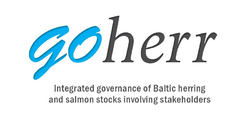Goherr: WP7 Dissemination
Objectives
Disseminate results to stakeholders and authorities
Description of work, and role of participants
Task 7.1 Preparing www-pages and flyers
At the outset of the project, www-pages and flyers presenting the project will be made.
Task 7.2 Developing and updating detailed communications plan
The aim of Task 7.2 is to organize different types of communication with stakeholders for the needs of WP2, WP3, WP4, WP5, and WP6. The communications plan will be updated periodically.
a) At the beginning of the project, interest groups / stakeholders related to the topic of the project (fisher organisations, authorities, decision makers, eNGOs, scientists) will be mapped, and informed about the project through 1) email and 2) in a meeting of the Baltic Sea Regional Advisory Council (BSRAC). All interest groups will be encouraged to follow the GOHERR www-pages, and communication will be active through the whole project.
b) The project will carry out total 40 interviews in four Baltic Sea countries (Finland, Sweden, Denmark,Estonia). The interviews cover all stakeholder groups (WP2).
c) Two questionnaire studies will be conducted: 1) A questionnaire study focusing on stakeholders’ preferences about objectives for Baltic salmon and herring management will be targeted to a selected group of people representing relevant stakeholder organisations (WP3, by UOULU, UH), and 2) A questionnaire study focusing on consumers’ eating habits related to Baltic salmon and herring, will be targeted to a wide sample of people from different Baltic Sea countries, month 18 (WP5, by THL, UH, and UOUL).
d) Two international workshops will be organized: 1) International Stakeholder Workshop No 1 (Month 10, Jan-Feb 2016 ), 2) International Stakeholder Workshop No 2 (Month 32, Nov 2017). The workshops will serve 1) data needs of WPs 2,3,5,6; 2) in establishing and maintaining interaction between the project and stakeholders, and 3) in presenting the aims, processes and results of the project (WP2, 3,4,5,6). The plan and program for the workshops will be defined in the Kick off meeting.
e) A Film short will be included on the website as a part of outreach (Month 20).
f) Two courses will be given for PhD students and PostDocs: 1) A course in marine governance in Aalborg University by IFM-AAU; 2) A course in decision analysis in the University of Helsinki by UH.
Task 7.3 Open linked data and models (UH, THL, IFM-AAU, SLU, UOULU)
The project will do its share in open linked data movement by opening up data and models that are collected or produced. The task will start from WP5 human data, month 6. Typically, the data will be opened when representative publications are published. Opasnet web workspace will be used as the main data repository. Others will pay special attention to the format of the data and models so that they will be easily reusable.
Deliverables timetable
D7.1 Project web-pages and electronic flyer (Month 2). Responsible partner: UH.
D7.2a,b Report of student training in Task 7.2f (courses on marine governance (IFM-AAU and decision analysis (UH) (M34). Responsible partners: IFM-AAU and UH.
D7.3 Developing and updating stakeholder communication plan (Month 36, start M2). Responsible partner: UH.
D7.4 Online material in Opasnet (report) (M36). Responsible partner: UH.
D7.5 Open linked data and models (M36). Responsible partner: UH.
D7.6 Report of stakeholder communication and involvement in the project (M36). Responsible partner: UH
Open linked data and models
- This is a foreword for deliverable D7.5 Open linked data and models, due March 2018. It purpose is to describe links of this rather theoretical and backward-looking paper with the Goherr work, especially shared understanding produced in workshops and other work. The actual deliverable is a manuscript of a scientific article: From open assessment to shared understanding: practical experiences.
The GOHERR BONUS project aimed to do its share in open linked data movement by opening up data and models that are collected or produced. THL has developed and maintains Opasnet web workspace for assessments, public discussions about policies, and data repository. Opasnet was chosen as the main data repository for GOHERR data and models.
However, Opasnet is not a typical data repository: its basic structure is built on knowledge crystals rather than on data tables from studies. Also, the work done in Opasnet is based on open policy practice, a methodology to increase the use of scientific knowledge in societal decision making.
Due to these reasons, the major products of the GOHERR project in Opasnet are not data tables such as the fish consumption survey in WP4, although it is also a product of the project and stored in Opasnet. The more important products are interpretations and increased understanding of complex issues related to the Baltic Sea and governance of fish stocks. These products are based on data from and work by GOHERR and elsewhere and are documented in Opasnet.
It is neither obvious how to synthesise data, discussions, and interpretations into knowledge crystals, nor common practice to do so. Therefore, we decided to write a summary paper of open policy practice methodology to clarify what Opasnet is and how to read its contents. The paper is mostly based on method development and assessments performed before GOHERR, but the final synthesis was done during GOHERR and for the GOHERR assessment and workshops.



